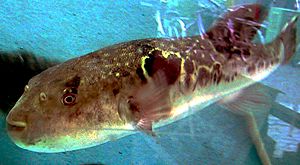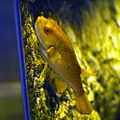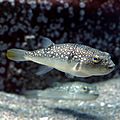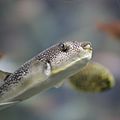Takifugu facts for kids
Quick facts for kids Takifugu |
|
|---|---|
 |
|
| Scientific classification |
|
| Kingdom: | Animalia |
| Phylum: | Chordata |
| Class: | Actinopterygii |
| Order: | Tetraodontiformes |
| Family: | Tetraodontidae |
| Subfamily: | Tetraodontinae |
| Genus: | Takifugu T. Abe, 1949 |
| Type species | |
| Tetrodon ocellatus Linnaeus, 1758
|
|
| Species | |
|
25, See species table below |
|
| Synonyms | |
|
Gastrophysus Müller, 1843 |
|
Takifugu is a group of pufferfish. They are often called fugu (河豚), which means "river pig" in Japanese. There are 25 different kinds of Takifugu fish. Most of them live in salty or slightly salty (brackish) waters in the northwest Pacific Ocean. Some also live in freshwater in Asia or in the wider Indo-Pacific area.
These fish mostly eat algae, molluscs, and other small invertebrates. Sometimes they eat crabs and shrimp. Pufferfish protect themselves by puffing up their bodies to become much bigger. They also have a strong poison. These defenses help them explore their surroundings without much fear of being attacked.
The fugu fish is very poisonous. But in Japan, it is seen as a special food, a delicacy. The fish has deadly amounts of a poison called tetrodotoxin. This poison is mostly in its internal organs, like the liver and ovaries. It is also found in the skin and testes.
Because of this danger, only chefs with special licenses can prepare and sell fugu. Eating the liver and ovaries is against the law. However, some people like the tiny tingling feeling that small amounts of the poison can give on the tongue. Sadly, every year, some people get very sick or even die if the fish is not prepared correctly.
The poison makes the muscles stop working, but the person stays fully awake. Eventually, they cannot breathe and die from suffocation. Right now, there is no cure for this poison. Doctors try to help the person breathe and keep their blood flowing until the poison wears off.
Fugu fish are also important in Japanese art and culture.
Contents
Where Takifugu Live and Their Safety Status
There are 25 different kinds of Takifugu fish. Most of them live in salty or slightly salty (brackish) waters in the northwest Pacific Ocean. But a few types live in the wider Indo-Pacific region or in freshwater in Asia. Most Takifugu cannot live in freshwater, even though some can handle different salt levels.
Two types are exceptions: the Takifugu obscurus and the Takifugu ocellatus. The Takifugu obscurus lives in coastal ocean waters but swims into fresh rivers to lay its eggs.
Most Takifugu species are not in danger of disappearing. However, two species are in serious trouble. The Takifugu chinensis is critically endangered, meaning it's very close to extinction. The Takifugu plagiocellatus is endangered.
The Takifugu rubripes is often used by scientists for research.
How Takifugu Look and Act
Takifugu fish are shaped like a pear. Like all pufferfish, they are not fast swimmers. They mostly use their side fins to move. But they are very good at turning and can even swim backward. They can change direction much faster than most other fish.
Because of this, you won't often find them in open water. They prefer to stay close to the sea floor. They like to explore places like oyster beds, seagrass meadows, and rocky reefs. These fish are very curious and active. Sometimes, they can even be aggressive towards other fugu or other fish.
Puffing Up for Safety
When a pufferfish feels danger, it puffs itself up. It fills its very stretchy stomach with water. If it's out of water, it uses air. This makes the fish almost perfectly round, like a sphere. That's why they are called blowfish or pufferfish.
Here's how they puff up: First, the pufferfish fills its mouth with water. Then, it seals its mouth with a special flap. This flap covers the whole mouth. Next, a special bone near its gills pushes the water down into its stomach. The stomach then stretches out a lot. Some fugu can become almost perfectly round.
What Takifugu Eat and How They Reproduce
Their diet mainly includes algae, mollusks, and other small invertebrates. They sometimes eat crabs and shrimp. All pufferfish have strong teeth. These teeth can grow too long if the fish doesn't eat hard foods that wear them down. Fugu can bite if they are bothered, and their bite is very painful.
Scientists haven't studied all Takifugu types in detail. The Takifugu rubripes is the most studied because it's raised on farms for people to eat. For example, Takifugu rubripes lays its eggs on rocks about 20 meters (66 feet) deep, usually from March to May.
Most Takifugu species live and lay eggs in marine (salty) or brackish water. The Takifugu obscurus is different. It moves from the ocean into fresh water to lay its eggs. A very unique way of laying eggs is seen in Takifugu niphobles. These fish gather on certain beaches. They throw themselves onto the land where the eggs are fertilized. Then they go back into the water. The eggs might float back into the water or stay under rocks on land. They only hatch when the high tide covers them again. This is a rare breeding behavior for pufferfish.
Fugu can also change their color over time. They can become darker or lighter. This helps them hide from predators. A very dark color can sometimes mean the fish is stressed or sick.
The Danger of Takifugu Poison
The main way the fugu fish protects itself is with a neurotoxin (a poison that affects nerves). This poison is found in its internal organs, especially the ovaries and the liver. There are smaller amounts in the intestines and skin. Only tiny amounts are found in the muscles and blood. This poison makes the fugu a deadly meal for most animals, including humans who might try to eat it.
The poison is called tetrodotoxin. It is about 1200 times more deadly than cyanide. This same poison is also found in other animals. These include the Blue-Ringed Octopus, cone snails, and even some newts. The pufferfish does not make the poison itself. Instead, tiny living things called bacteria, like Pseudomonas, create it inside the fish. The fish gets these bacteria by eating food that contains them.
Pufferfish born and raised in captivity do not have tetrodotoxin. They only become poisonous if they eat food that has these poison-making bacteria. Also, some fugu fish are more poisonous than others. Just one fish can have enough poison to kill about thirty adult humans.
Takifugu DNA
Scientists have found that pufferfish have the smallest genome (all the DNA in an organism) of any vertebrate animal. This is because they have much less "junk" DNA (non-coding DNA) compared to other animals. Even though their genome is small, it has all the important genetic information that other fish and vertebrates have.
Because their genomes are so small, it's easier and cheaper to map their complete DNA sequences. This has been done for two types of pufferfish: Takifugu rubripes and Tetraodon nigroviridis. The Takifugu rubripes was the second vertebrate animal in history to have its entire genome mapped, after humans. This makes them very important for scientific research.
Species of Takifugu
The group of fish called Takifugu is sometimes also known by its older name, Fugu. As of 2012, there are 25 known species in this group:
| Image | Species | Author | Common name | Distribution | Max. size | Comments |
|---|---|---|---|---|---|---|
| Takifugu alboplumbeus | (J. Richardson, 1845) | Komon-damashi (Japan) | West Pacific | 23 centimetres (9.1 in) SL | Poisonous, Salt Water | |
| Takifugu bimaculatus | (J. Richardson, 1845) | Futatsuboshi-fugu (Japan) | Northwest Pacific | 30 centimetres (12 in) SL | Poisonous | |
| Takifugu chinensis* | (T. Abe, 1949) | Eyespot Puffer, Karasu (Japan) | Northwest Pacific | 55 centimetres (22 in) SL | Poisonous | |
 |
Takifugu chrysops* | (Hilgendorf, 1879) | Red-eyed Puffer, Akamefugu (Japan) | Northwest Pacific | 20 centimetres (7.9 in) SL | Poisonous |
| Takifugu coronoidus | Y. Ni & C. S. Li, 1992 | 暈環多紀魨 (China) | Northwest Pacific | ? | Not poisonous? | |
 |
Takifugu exascurus | (D. S. Jordan & Snyder, 1901) | Mushifugu (Japan) | Northwest Pacific | 15 centimetres (5.9 in) SL | Poisonous |
| Takifugu flavidus | (C. S. Li?, C. X. Wang & Y. G. Wang, 1975) | Yellowbelly pufferfish, Towny puffer, Sansaifugu (Japan), Hwang-jom-pok (Korea), Jú húng dong fang tún (China) | Northwest Pacific | 35 centimetres (14 in) SL | Poisonous | |
 |
Takifugu niphobles* | (D. S. Jordan & Snyder, 1901) | Grass Puffer, Starry puffer, Kusafugu (Japan), Cá Nóc sao (Viet Nam) | Northwest Pacific | 15 centimetres (5.9 in) TL | Poisonous |
| Takifugu oblongus | (Bloch, 1786) | Oblong blow fish, Lattice blaasop (India), Bebo (India) Buntal (Malaysia), Pita-pita (Indonesia), Ruitjies-blaasop (South Africa) | West Pacific | 40 centimetres (16 in) TL | Poisonous | |
| Takifugu obscurus* | (T. Abe, 1949) | Obscure Puffer, Mefugu (Japan) | Western Pacific | 40 centimetres (16 in) SL | Poisonous | |
| Takifugu ocellatus | (Linnaeus, 1758) | Ocellated Puffer | Asia | 15 centimetres (5.9 in) TL | Poisonous | |
| Takifugu orbimaculatus | Y. D. Kuang, C. S. Li & S. H. Liang, 1984 | 圓斑多紀魨 (China) | Asia | ? | Not Poisonous? | |
 |
Takifugu pardalis* | (Temminck & Schlegel, 1850) | Panther puffer, Higanfugu (Japan), Chol-pok (Korea), Bào wén dong fang tún (China) | Northwest Pacific | 30 centimetres (12 in) SL | Poisonous |
| Takifugu plagiocellatus | C. S. Li, 2002 | Northwest Pacific, China | 10.9 centimetres (4.3 in) SL | |||
 |
Takifugu poecilonotus* | (Temminck & Schlegel, 1850) | Fine Patterned Puffer, Komonfugu (Japan), Huin-jom-pok (Korea), Ban dian dong fang tún(斑点东方鲀) (China) | Northwest Pacific | 20 centimetres (7.9 in) SL | Poisonous |
 |
Takifugu porphyreus* | (Temminck & Schlegel, 1850) | Purple Puffer, Namera-fugu (Japan), Mafugu (Japan), Kom-pok (Korea), Zi sè dong fang tún) (China) | Northwest Pacific | 52 centimetres (20 in) TL | Poisonous |
| Takifugu pseudommus | (Y. T. Chu, 1935) | Nameradafugu (Japan), Nameradamashi (Japan) | Northwest Pacific | 35 centimetres (14 in) SL | Poisonous | |
| Takifugu radiatus | (T. Abe, 1947) | Nashifugu (Japan) | Northwest Pacific | 20 centimetres (7.9 in) SL | Poisonous | |
| Takifugu reticularis | (M. C. Tian, Q. T. Cheng & Q. Wang, 1975) | Reticulate Puffer, Amime-fugu (Japan) | Northwest Pacific | 29 centimetres (11 in) SL | Poisonous | |
| Takifugu rubripes* | (Temminck & Schlegel, 1850) | Torafugu (Japan), Japanese Puffer, Tiger Puffer, Hóng qí dong fang tún(红鳍东方鲀) (China), Cha-ju-pok (Korea) | Northwest Pacific | 80 centimetres (31 in) TL | Poisonous, Used in Chinese Medicine, Genome sequenced completely | |
 |
Takifugu snyderi* | (T. Abe, 1988) | Shosai-fugu (Japan) | Western Pacific | 30 centimetres (12 in) SL | Poisonous |
| Takifugu stictonotus* | (Temminck & Schlegel, 1850) | Spotback, Spottyback Puffer, Gomafugu (Japan) | Northwest Pacific | 35 centimetres (14 in) SL | Poisonous | |
| Takifugu variomaculatus | C. S. Li & Y. D. Kuang, 2002 | Northwest Pacific, China | 13.7 centimetres (5.4 in) SL | |||
| Takifugu vermicularis | (Temminck & Schlegel, 1850) | Purple Puffer, Pear Puffer, Shosaifugu (Japan), Nashifugu (Japan), Kuk-mae-ri-bok (Korea), Chóng wén dong fang tún (China) | Northwest Pacific | 30 centimetres (12 in) SL | Poisonous | |
| Takifugu xanthopterus* | (Temminck & Schlegel, 1850) | Yellowfin puffer, Shimafugu (Japan), Kka-ch'i-pok (Korea), Tiáo wén dong fang tún (China) | Northwest Pacific | 50 centimetres (20 in) SL | Poisonous |
* Fish that have edible body parts according to the Japanese Ministry of Health and Welfare
See also
 In Spanish: Takifugu para niños
In Spanish: Takifugu para niños

